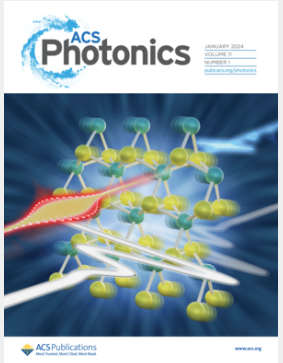多功能分子空穴传输界面工程实现高效无镉蓝色量子点发光二极管
IF 6.7
1区 物理与天体物理
Q1 MATERIALS SCIENCE, MULTIDISCIPLINARY
引用次数: 0
摘要
高性能蓝色量子点发光二极管(qled)在全彩显示中具有巨大的应用潜力。然而,生态友好型纯蓝色qled的实现受到最高已占据分子轨道(HOMO)水平较浅和空穴输运层(HTLs)电导率较低的限制。在这里,一个简单的策略掺杂HTL与多功能分子,即银双(三氟甲基磺酰基)亚胺(Ag-TFSI),被证明。这种p掺杂策略同时改善了HTL/QD界面的能级排列,增强了HTL的导电性,并防止量子点(QDs)带电。受益于更好的电荷平衡和减轻激子的非辐射重组,蓝色锌碲硒qled (znese)显示出峰值外量子效率(EQE)为13.9%,电发光发射位于456nm。此外,设备寿命延长了两倍以上。这项工作提出了一个有前途的p掺杂策略,以加速环保qled向显示应用的发展。本文章由计算机程序翻译,如有差异,请以英文原文为准。

High-Efficiency Cadmium-Free Blue Quantum Dot Light-Emitting Diodes Enabled by Engineering of a Hole Transporting Interface with a Multifunctional Molecule
High-performance blue quantum dot light-emitting diodes (QLEDs) have great potential application in full-color display. However, realization of eco-friendly pure-blue QLEDs is limited by the shallow highest occupied molecular orbital (HOMO) level and low conductivity of hole transport layers (HTLs). Here, a facile strategy of doping the HTL with a multifunctional molecule, i.e., silver bis(trifluoromethylsulfonyl)imide (Ag-TFSI), is demonstrated. This p-doping strategy simultaneously improves the energy level alignment at the HTL/QD interface and enhances the conductivity of the HTL, as well as prevents quantum dots (QDs) from getting charged. Benefiting from the better charge balance and mitigated nonradiative recombination of excitons, the blue zinc tellurium selenium (ZnTeSe)-based QLEDs exhibit a peak external quantum efficiency (EQE) of 13.9% with an electroluminance emission located at 456 nm. Moreover, the device lifetime is enhanced by more than twofold. This work suggests a promising p-doping strategy to accelerate the development of eco-friendly QLEDs toward display applications.
求助全文
通过发布文献求助,成功后即可免费获取论文全文。
去求助
来源期刊

ACS Photonics
NANOSCIENCE & NANOTECHNOLOGY-MATERIALS SCIENCE, MULTIDISCIPLINARY
CiteScore
11.90
自引率
5.70%
发文量
438
审稿时长
2.3 months
期刊介绍:
Published as soon as accepted and summarized in monthly issues, ACS Photonics will publish Research Articles, Letters, Perspectives, and Reviews, to encompass the full scope of published research in this field.
 求助内容:
求助内容: 应助结果提醒方式:
应助结果提醒方式:


